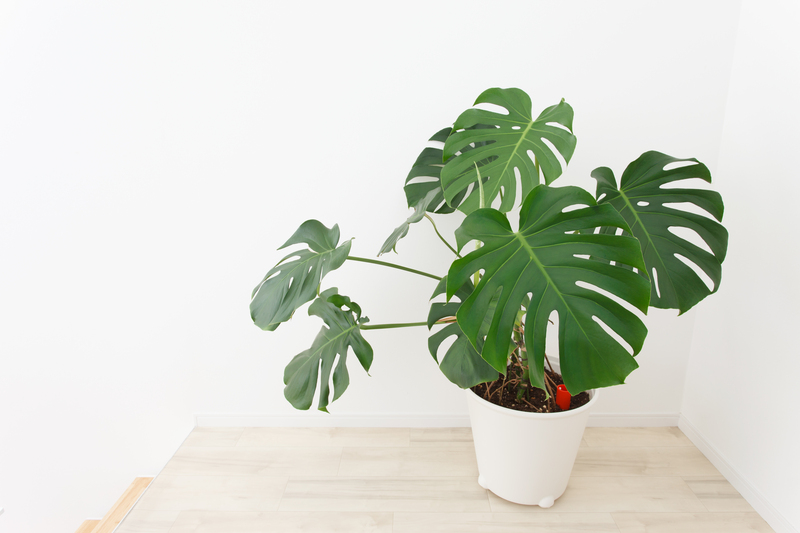Nurturing Young Gardeners with Thoughtful Spaces
Posted on 15/09/2025
Nurturing Young Gardeners with Thoughtful Spaces
Creating a garden isn't just about flowers and vegetables--it's an opportunity to nurture curiosity, responsibility, and a lifelong love of nature in children. Thoughtful gardening spaces for young gardeners offer more than just a patch of dirt; they are workshops of discovery, centers of sensory play, and sanctuaries for personal growth. Whether you have acres or a balcony, embracing child-friendly gardening spaces can make a remarkable difference in the way children experience the outdoors.
The Importance of Outdoor Learning and Connection With Nature
In today's fast-paced, technology-centric world, opportunities for kids to connect with nature have become increasingly limited. Engaging children with gardening provides multiple benefits for their physical, emotional, and social development:
- Boosts Sensory Development: Touching soil, smelling herbs, watching seeds grow--it's all hands-on, encouraging sensory exploration.
- Supports Mental Health: Time outdoors can ease stress and anxiety, improving overall wellbeing.
- Improves Focus: Studies have shown that children who spend time in natural environments have improved attention spans and learning abilities.
- Builds Responsibility: Taking care of plants helps instill a sense of accountability and patience.
- Promotes Healthy Habits: Kids who grow their own food are more likely to eat vegetables and make healthier choices.

Understanding What Inspires Young Gardeners
Before designing a thoughtful gardening space for your child, it's helpful to understand what fuels their excitement. Children are natural explorers and thrive in environments that are:
- Interactive: Spaces that invite touch, movement, and experimentation promote deeper learning.
- Accessible: Raised beds, small planters, and reachable tools ensure every child can participate.
- Colorful and Varied: Bright blooms and interesting textures capture imagination and interest.
- Safe: Avoiding toxic plants and using kid-friendly tools is essential to confident exploration.
Engaging young gardeners requires more than just setting aside an area; it's about sparking imagination, empowering independence, and fostering curiosity.
Planning a Child-Friendly Garden Space
Every child and every garden is unique, but thoughtful design is essential for nurturing young gardeners. Here's how to develop a space that encourages kids to get their hands dirty:
Choosing the Right Location
- Visibility: Opt for a visible spot to keep an eye on children and celebrate their progress.
- Accessibility: The space should be easy to reach, with nearby water sources and safe paths.
- Sunlight: Most plants require at least 6 hours of direct sunlight; observe sun patterns before building beds.
Designing for Engagement and Safety
- Defined Borders: Use logs, stones, or other non-toxic materials to help children identify their garden boundaries.
- Safe Surfaces: Paths made of mulch or rubber tiles prevent slips and trips.
- Shelter and Shade: Child-sized structures, like teepees or small gazebos, provide relief from the sun and a space to relax.
Tools and Materials for Young Gardeners
- Light, sturdy hand shovels and trowels
- Watering cans sized for small hands
- Gardening gloves in children's sizes
- Easy-to-lift pots and containers
- Colorful plant labels for identification
When selecting materials, prioritize safety and ease of use. Encourage independence by offering lightweight, kid-friendly tools and containers.
Selecting Plants for a Kid-Friendly Garden
Selecting the right plants is essential for success in nurturing the next generation of gardeners. Look for plants that are:
- Fast-growing: Radishes, sunflowers, and beans provide visible results within weeks--rewarding short attention spans.
- Sensory: Lamb's ear (soft leaves), mint (fragrant foliage), and snapdragons (wonderful blooms) invite touch and smell.
- Colorful: Marigolds, nasturtiums, and zinnias offer dazzling displays throughout the growing season.
- Edible: Cherry tomatoes, strawberries, and peas are delicious straight from the stem, making harvests extra rewarding.
*Avoid toxic plants like foxglove, oleander, and certain lilies*. Consult local extension services for regional guidance.
Theme Gardens: Sparking Creativity
Another effective way to engage young gardeners is by creating theme gardens. Consider these inspiring ideas:
- Pizza Garden: Grow tomatoes, basil, peppers, and oregano--then use them to make pizza together!
- Butterfly Garden: Plant milkweed, coneflowers, and asters to attract pollinators and observe transformation firsthand.
- Sensory Garden: Arrange plants with contrasting textures, colors, and scents to stimulate all senses.
- Fairy Garden: Miniature furniture, colorful stones, and tiny fairy houses add whimsy and magic to any space.
Cultivating Learning Through Gardening Activities
Beyond planting and watering, nurturing young gardeners means turning routine chores into meaningful learning opportunities. Here's how to make the most of every season:
Spring: Sowing the Seeds of Curiosity
- Start seeds indoors and track their progress in a journal.
- Experiment with germinating seeds in clear plastic bags to watch root systems develop.
- Visit local garden centers and let kids choose a favorite plant to care for.
Summer: Sunlit Exploration
- Set up scavenger hunts for insects, flowers, and interesting leaves.
- Encourage taste tests of fresh garden produce--what's sweet, sour, spicy, or bitter?
- Make homemade garden art: paint rocks, make plant labels, or build simple bird feeders.
Autumn: Harvest and Reflection
- Collect seeds for next year's planting and learn about seed saving.
- Compost fallen leaves and garden clippings to discuss nature's recycling.
- Host a harvest party to celebrate all the hard work and flavors of the season.
Winter: Indoors and Imagination
- Decorate pots and plant easy houseplants like spider plants or succulents.
- Create garden plans and wish lists for springtime.
- Read books about famous gardens or garden-based adventures for inspiration.
By intentionally integrating nature-based activities year-round, you can ensure every child's connection to the garden remains vibrant and relevant.
Encouraging Creativity and Ownership in Young Gardeners
A thriving children's garden is more than just a place to plant seeds--it's a canvas for creativity and a training ground for independence. To nurture young gardeners with thoughtful garden spaces, encourage them to:
- Personalize: Allow kids to decorate plant markers, paint stones, or design the layout of their plot.
- Take Responsibility: Assign regular tasks, like watering or weeding, and celebrate progress.
- Record Progress: Use photos and drawings to document plant growth and garden changes.
- Experiment: Let them try planting seeds in unexpected places or using upcycled containers.
When kids have ownership, they become more invested in the outcome, taking pride not only in the harvest, but also in the process itself.
Overcoming Challenges in Kids' Gardening Spaces
Establishing a flourishing garden for children may come with a set of obstacles. Some common challenges and tips for addressing them include:
- Short Attention Spans: Choose quick-germinating seeds and break tasks into small, achievable steps.
- Pests and Diseases: Teach children about beneficial and harmful insects, and encourage natural solutions like hand-picking or companion planting.
- Impatience or Disinterest: Rotate tasks and let children choose their own garden projects to maintain enthusiasm.
- Limited Space: Utilize vertical gardens, window boxes, and container gardening to make the most of small areas.
By creating engaging, flexible, and nurturing gardening spaces, these challenges can become opportunities for growth and resilience.
The Lasting Impact of Nurturing Young Gardeners
The journey of encouraging young gardeners with thoughtful spaces offers children more than a love for plants. It equips them with life skills--self-reliance, patience, creativity, empathy--and an appreciation for the interconnectedness of all living things. Child-oriented gardens help foster stewardship of the environment and empower youth to become advocates for a greener future.
By creating *welcoming garden spaces for kids*, you plant seeds that yield benefits for a lifetime. Gardens teach more than science and botany--they teach kindness, wonder, and respect.
Getting Started: Tips for Parents, Teachers, and Community Leaders
If you're ready to embark on the journey of nurturing young gardeners, these simple tips can help launch your program or backyard project:
- Start Small: A single raised bed or a few pots can yield fantastic results, especially for young children.
- Be Inclusive: Involve children in every step--from choosing seeds to designing the space and harvesting produce.
- Work With the Seasons: Take advantage of seasonal changes to highlight different gardening activities.
- Celebrate Success: Share photos, host garden parties, or create certificates to acknowledge children's accomplishments.

Resources for Continuing the Journey
For those interested in deepening their knowledge or finding inspiration, consider these excellent organizations and books focused on gardening for children:
- National Gardening Association: Offers a Kids Gardening section with activity ideas and grants.
- Royal Horticultural Society - Campaign for School Gardening: Provides free, practical resources for schools and home educators.
- Books: "Roots, Shoots, Buckets & Boots" by Sharon Lovejoy; "Gardening Lab for Kids" by Renata Brown.
- Local Botanical Gardens: Many offer family-friendly workshops and seasonal programs.
Conclusion: Sowing Seeds for the Future
Creating thoughtful spaces for young gardeners is a gift that continues to grow long after the last harvest. With intentional design, creative activities, and plenty of encouragement, you can cultivate a love of gardening in children that will flourish for years to come. Whether at home, in schools, or within communities, every garden planted for a child is an investment in a greener, healthier, and more vibrant future for us all.
Start nurturing your young gardener today--every seed you sow plants hope for tomorrow.

